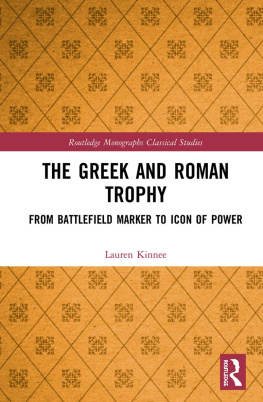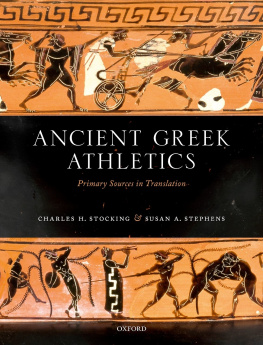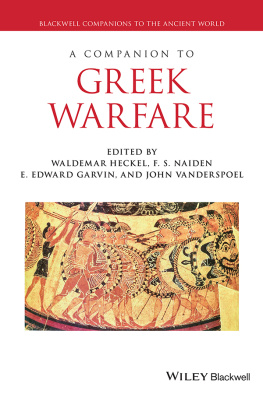The Greek and Roman Trophy
In this volume Kinnee offers a comprehensive account of the development of the trophy in Greek and Roman culture. Combining study of the literary and archaeological evidence with insights from anthropology and the history of religions, she offers a provocative new interpretation of the Greek trophy, radically different from the icon of power it later became.
Zahra Newby, University of Warwick, UK
In The Greek and Roman Trophy: From Battlefield Marker to Icon of Power, Kinnee presents the first monographic treatment of ancient trophies in sixty years. The study spans Archaic Greece through the Augustan Principate. Kinnee aims to create a holistic view of this complex monument-type by breaking down boundaries between the study of art history, philology, the history of warfare, and the anthropology of religion and magic. Ultimately, the kaleidoscopic picture that emerges is of an ad hoc anthropomorphic Greek talisman that gradually developed into a sophisticated, Augustan sculptural or architectural statement of power. The former, a product of the hoplite phalanx, disappeared from battlefields as the Macedonian cavalry grew in importance, shifting instead onto coins and into rhetoric, where it became a statement of military might. For their part, the Romans seem to have encountered the trophy as an icon on Syracusan coinage. Recognizing its value as a statement of territorial ownership, the Romans spent two centuries honing the trophy-concept into an empire-building tool, planted at key locations around the Mediterranean to assert Roman presence and dominance.
This volume covers a ubiquitous but poorly understood phenomenon and will therefore be instructive to upper-level undergraduates, graduate students, and scholars in all fields of Classical Studies.
Lauren Kinnee is the Director of Art History and Visiting Assistant Professor at the University of Colorado at Colorado Springs, USA.
Routledge Monographs in Classical Studies
https://www.routledge.com/classicalstudies/series/RMCS
Titles include:
The Etruscans and the History of Dentistry
Marshall J. Becker and Jean MacIntosh Turfa
Masculinity and Dress in Roman Antiquity
Kelly Olson
Juvenals Global Awareness
Osman Umurhan
The Greek and Roman Trophy
Lauren Kinnee
Forthcoming:
Thinking the Greeks
Edited by Lillian Doherty and Bruce King
The Getae
Edited by Ioana Oltean, Ligia Ruscu and Dan Ruscu
Un-Roman Sex
Edited by Rob Collins and Tatiana Ivleva
Divinations and Systems of Knowledge in Greco-Roman Antiquity
Edited by Crystal Addey and Victoria Leonard
Villas and Values
Hannah Platts
The Doctor in Roman Law and Society
Molly Jones-Lewis
First published 2018
by Routledge
2 Park Square, Milton Park, Abingdon, Oxon OX14 4RN
and by Routledge
711 Third Avenue, New York, NY 10017
Routledge is an imprint of the Taylor & Francis Group, an informa business
2018 Lauren Kinnee
The right of Lauren Kinnee to be identified as author of this work has been asserted by her in accordance with sections 77 and 78 of the Copyright, Designs and Patents Act 1988.
All rights reserved. No part of this book may be reprinted or reproduced or utilised in any form or by any electronic, mechanical, or other means, now known or hereafter invented, including photocopying and recording, or in any information storage or retrieval system, without permission in writing from the publishers.
Trademark notice: Product or corporate names may be trademarks or registered trademarks, and are used only for identification and explanation without intent to infringe.
British Library Cataloguing-in-Publication Data
A catalogue record for this book is available from the British Library
Library of Congress Cataloging-in-Publication Data
Title: The Greek and Roman trophy / Lauren Kinnee.
Description: Abingdon, Oxon; New York, NY: Routledge, 2018. |
Series: Routledge monographs in classical studies | Outgrowth of the authors thesis (doctoralNew York University, 2011) under the title: Roman trophy from battlefield marker to emblem of power. | Includes bibliographical references and index.
Identifiers: LCCN 2017048398 (print) | LCCN 2017052777 (ebook) | ISBN 9781315225333 (ebook) | ISBN 9781351846585 (web pdf) | ISBN 9781351846578 (epub) | ISBN 9781351846561 (mobi/kindle) | ISBN 9780415788380 (hardback: alk. paper) | ISBN 9781315225333 (ebook: alk. paper)
Subjects: LCSH: Military trophies in art. | Art, GreekThemes, motives. | Art, RomanThemes, motives. | Military trophiesGreeceHistoryTo 1500. | Military trophiesRome.
Classification: LCC N8224.M49 (ebook) | LCC N8224.M49 K56 2018 (print) | DDC 709.495dc23
LC record available at https://lccn.loc.gov/2017048398
ISBN: 978-0-415-78838-0 (hbk)
ISBN: 978-1-315-22533-3 (ebk)
Typeset in Times New Roman
by Sunrise Setting Ltd., Brixham, UK
I dedicate this book to Zeus Tropaios
Contents
I would like to thank my dissertation advisor, Katherine E. Welch, for her encouragement and guidance throughout my graduate career. She consistently challenged me, broadened my intellectual purview, and sharpened my skills as a scholar. I also owe a great debt of gratitude to James R. McCredie, who served as a mentor and provided countless hours of instruction and assistance that went above and beyond requirements or expectations. I am especially grateful to T. Corey Brennan, who helped hone the book in its final hours and who provided invaluable insight into the historical and philological aspects of my project, as well as unflagging encouragement. In addition, I am indebted to Gnter Kopcke and Thelma Thomas for reading early drafts of my manuscript.
I would like to acknowledge the advice, assistance and input of a bevy of other scholars as well: Clemente Marconi for crucial input regarding the Greek visual culture of warfare; Peter Schultz and Andrew Stewart for hours of conversation and drives through Boeotia; William Murray for allowing me to join him for several days in his examination of the Nikopolis monument; Gregory Bucher for constant support and for his philological input; and of course Kathryn Blair Moore for acting as a coach, a brainstorming partner and a lifeline. I would be remiss in my duties if I did not also thank Judith M. Barringer for stimulating my interest in antiquity and for being the first to teach me how to think about the Classical world.
The completion of this book would not have been possible without the financial backing of the Institute of Fine Arts at New York University, the American School of Classical Studies in Athens, and the American Academy in Rome. All three of these institutions not only funded my research, but also greatly contributed to my academic formation. I am also grateful to Routledge Press, the anonymous reviewers, and especially to my editor Elizabeth Risch for her patience and assistance with problems large and small.
I owe a more personal debt of gratitude to my parents, Gale Murray and Sandy Kinnee, and to my husband, Jeffrey Wilbur, for standing by me through this process and making it possible for me to finish. For that, I also must thank Cynthia Rose.
AA: | Archologischer Anzeiger |
AdI: | Annali dellIstituto di corrispondenza archeologica |









